Design Team Aims to Create the Most Preferred Financial Group Through the Power of Design
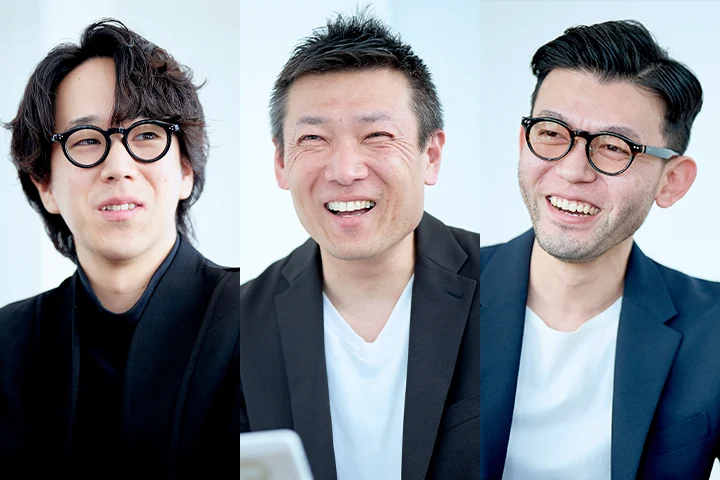
The in-house designers in the Strategic Planning Group of SMBC’s Retail IT Strategy Department have taken on the mission of making SMBC the most preferred financial group through the power of design. Combining their diverse backgrounds, design team members are creating new value for the SMBC Group through their out-of-the-box design thinking.
Here we delve deeper into the design thinking so prized by a team involved in everything from UI/UX design for smartphone apps and websites to design system construction and service design. We also explore the spirit of challenge underpinning their efforts to update the value that designers bring to the Group.
Customer-centric thinking
In December 2016, an in-house design team was set up within the Retail IT Strategy Department to respond to the rapid transformation in customer touchpoints wrought by digitalization. Hopes were high that the new team might be one of the organizations that can work out how to deliver more value to customers in an era where those touchpoints were increasingly shifting from physical stores to the digital space.
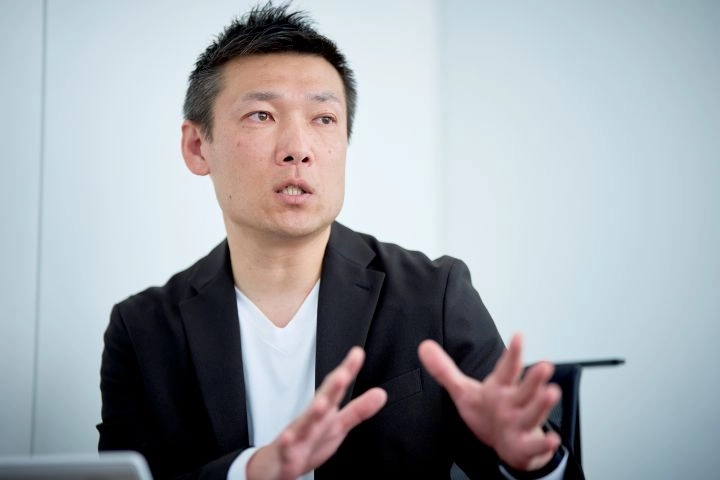
Designers often join projects from the development phase after business and service directionality and requirement definitions have been established, but by then it’s hard to backtrack. We think it’s important to participate right from the early planning phase so that we can design not just the how of product or service delivery but the more fundamental question of what to deliver.
The team views customer-centric thinking as essential in delivering value.
The designer’s job is to give shape to customer needs, and that means taking off your service provider hat to really think about what would be best for the customer. I believe that fusing that approach with SMBC’s values as a bank opens the way for a better result.
It’s important to visualize who will be using those functions and services, as well as how the user’s behavior will change and what emotional shift they will undergo as a consequence.
The team currently comprises 13 designers with very different career backgrounds, and as the manager, Kotaro Matsushita aims to take advantage of that diversity in team building.
Taking advantage of the team’s tremendous diversity, I make a real effort not to assign fixed roles but rather to give everyone as much freedom as possible. Obviously, there are certain musts laid down by company policy, but I try to assign team members to projects very much based on what they can and also have the will to do.
Becoming a designer―at a megabank!
Matsushita previously worked primarily in industrial design. He joined a general electronics major straight out of university, handling hardware product design within the design arm of the company’s R&D department. He later moved over to business development and innovation methodology research, gaining experience in completely different aspects of design.
I spent around 20 years working in various areas of design for a manufacturer, but I always thought it would be great to be directly involved in business policy, planning, development, and sales in a business unit rather than in R&D.
It was because he wanted that direct business involvement in a company’s profit center while also making use of his design skills that Matsushita choose SMBC.
I’ve always had an interest in finance as a key element of civil and business infrastructure―in fact, I majored in social systems design in grad school, and the department I belonged to in my former job had co-created services with a financial institution. My other motivation for joining SMBC was that I wanted to be part of the great upheaval as Japan’s megabanks work out how to transform their business to deal with the rapid advance of digitalization.
Neither Okazaki nor Oyasu started out working as designers.
Okazaki originally worked in sales at an advertising agency. Looking back, he thinks that it was his desire to give his ideas form as a creator that prompted his career shift.
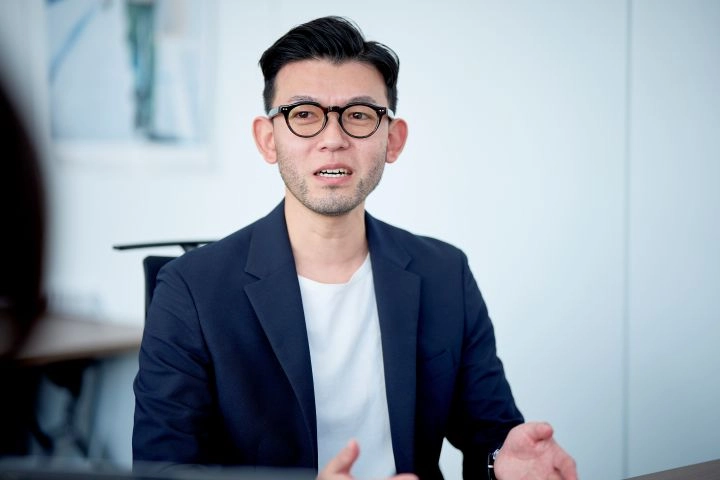
I taught myself graphic design and built up a track record as a freelance designer. I got a job as a designer at an advertising agency in Singapore, but I crashed and burned almost immediately and had to come home. It was a crushing but pivotal moment in my career.
Feeling that it was do or die, Okazaki subsequently talked his way through the door of an IT venture company that needed a designer, then went to the United States to work on product and UI/UX design for a cosmetics firm. Returning to Japan, he was looking around for a company that was doing something interesting when he stumbled across the SMBC design team.
When I did some digging, I found that other designers on the team had the same sales background as me. The fact that there was someone already on board pursuing my dream career gave me the push to join SMBC.
Oyasu started his career as a web director but decided to become a UX designer instead because he wanted to create the kind of services that both he and many other people out in society would want to use. Then, feeling the need to be involved in all aspects of product creation, he decided to make the move to an operating company.
Oyasu chose SMBC for the chance to work with a range of professionals in the totally different environment of a megabank and to make products from a customer perspective.
Money is so important to so many people that it has a huge impact on society and on daily life. I also thought that it would be a great experience to work within a big organization with a strong design culture where designers can have active project involvement.
Proving the power of design with future-facing proposals
Matsushita finds the real thrill of digital product development in the opportunity to shape the way in which a megabank transforms its business to meet the challenges of digitalization.
By scaling out its know-how, even a small team can lift the level of a huge corporate group. That ripple effect is hugely attractive.
One specific example of that knowledge scale-out is the refining of SMBC’s design system, which is accessible within the SMBC Group. Following the rules of that system supports a consistent UX.
Okazaki’s experience with that particular project brought home to him both the difficulty and the rewards of being involved in design in finance as an element of social infrastructure.
To make SMBC’s services universally available, it’s important to ensure the web accessibility of digital services, which means considering people with visual or hearing impairments, for example. Redefining our rules for UI, etc., required a lot of discussion and a lot of design time, and even now we’re continuing to explore ways of building web accessibility rules into our design system.
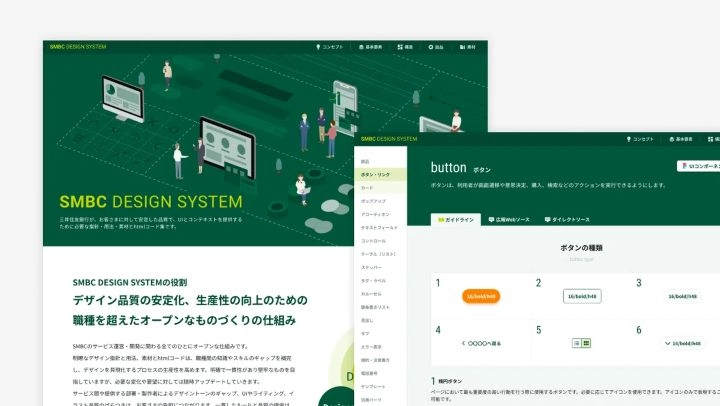
Since joining SMBC, Oyasu is often struck by how strongly design thinking permeates the whole organization despite its considerable size, and the design system is a prime example of this.

HCD-Net Certified Human Centered Design Professional
I really feel that we’re working on a project together with the planners and developers. In the early planning stages, they will come to us designers for our ideas as a matter of course and we will naturally take ideas to them as well, with designers expected to play a significant role. Design proposals should embody the value that the design will create for users and the business, but it’s also important that, as part of that process, designers in particular envisage how society will change in the future.
Matsushita sees this receptiveness to new ideas and the willingness to take on challenges and change as key strengths of the SMBC Group
It’s amazing that a major firm with such a long tradition retains such a vibrant, venture-like mindset and spirit of challenge. To my mind, it shows that the blood of the two companies from which SMBC originates still flows strongly through its veins: Sumitomo, which got its start as a copper smelting tech venture, and Mitsui, a business innovator that introduced the groundbreaking practice of cash sales at fixed prices in its kimono store.
Growing Group fans and making SMBC an innovation leader
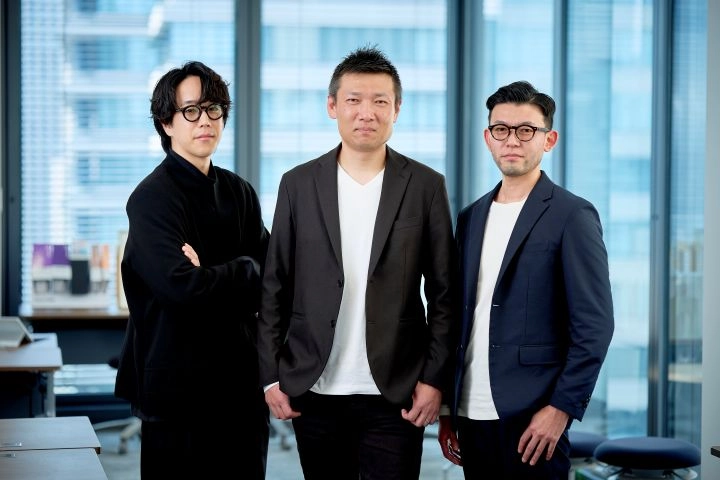
Finding great appeal in both design itself and the different approach to design enabled by SMBC’s intrepid spirit, Okazaki and Oyasu are determined to step up the SMBC Group’s presence.
I want to find ways to grow the pool of SMBC Group fans so that, amidst all the competition, people choose our services expressly because they’re SMBC Group services.
My goal is to support the SMBC Group in going beyond the bounds of banking and finance to become a recognized innovation leader.
To help realize these dreams, Matsushita sees his role as solidifying the position of the design team by extending its value within and beyond the Group.
I’m constantly exploring opportunities for our designers to be involved in areas beyond superficial design and to upgrade their skills so that they’re prepared for those opportunities―and I also welcome anyone with broad-ranging skills who wants to create SMBC Group fans and change society through the power of design to come join our design organization.
His vision is to make SMBC the financial group of choice for consumers by maximizing the power of design.
We’re constantly exchanging some form of value in our daily lives. Playing our part in shaping the infrastructure for that value exchange is a heavy responsibility, but it also means that our ideas can have major social impact, and that’s the best part of being involved in design for a financial institution. My aim is to use the groundwork laid by the business planners and designers who came before us to take SMBC Group’s presence to the next level.
* The content of the article is current as at April 2025.
-

Design Manager & Senior Vice President, Strategic Planning Group, Retail IT Strategy Department, Sumitomo Mitsui Banking Corporation
Kotaro Matsushita
Joined a general electronics major in 2004, handling hardware product and service design development and research on innovation creation methods. Entered SMBC in 2023. Drives examination of design expansion strategies and financial digital service planning for the SMBC Group.
-

UI/UX Designer, Strategic Planning Group, Retail IT Strategy Department, Sumitomo Mitsui Banking Corporation
Junya Okazaki
Began his career in sales at a full-service advertising agency in 2009. After a stint as a graphic designer at an advertising agency in Singapore, he worked at an IT venture firm, a web marketing firm, in product design at a US cosmetics manufacturer, and in other fields before coming on board with SMBC in 2022.
-

Service Designer, Strategic Planning Group, Retail IT Strategy Department, Sumitomo Mitsui Banking Corporation
HCD-Net Certified Human Centered Design ProfessionalKeito Oyasu
Began his career as a web director at a group company of a telecommunications firm in 2017. Subsequently switched to UX design and joined SMBC in 2024.
